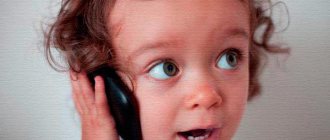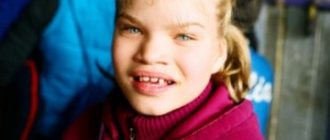The success of human life, in addition to objective circumstances, is also influenced by the level of self-esteem, which begins to form in the preschool period under the influence of the child’s environment, primarily parents. Self-esteem is a person’s assessment of his capabilities, qualities and place among other people.
A healthy atmosphere in the family, the desire to understand and support the child, sincere participation and empathy, a sense of psychological security - these are the components for the formation of positive adequate self-esteem in the child.
A child with high self-esteem may believe that he is right in everything. He strives to control other children, seeing their weaknesses, but not seeing his own, often interrupts, treats others down, and tries with all his might to attract attention to himself. From a child with high self-esteem you can hear: “I am the best.” With inflated self-esteem, children are often aggressive and belittle the achievements of other children.
If a child's self-esteem is low , most likely he is anxious and unsure of his own abilities. Such a child always thinks that he will be deceived, offended, underestimated, always expects the worst, and builds a defensive wall of mistrust around himself. He strives for solitude, is touchy, and indecisive. Such children adapt poorly to new conditions. When performing any task, they are set up for failure, finding insurmountable obstacles. Children with low self-esteem often refuse new activities for fear of failure, overestimate the achievements of other children and do not attach importance to their own successes.
Low, negative self-esteem in a child is extremely unfavorable for the full development of the individual. Such children are in danger of developing the attitude “I am bad”, “I can’t do anything”, “I am a loser”.
With adequate self-esteem, the child creates around himself an atmosphere of honesty, responsibility, compassion and love. He feels valued and respected. He believes in himself, although he is able to ask for help, is able to make decisions, and can admit that there are mistakes in his work. He values himself, and therefore is ready to value those around him. Such a child has no barriers that prevent him from experiencing a variety of feelings towards himself and others. He accepts himself and others as they are.
If you praise, then it’s right
Of great importance in the formation of a child’s self-esteem is the interested attitude of an adult, approval, praise, support and encouragement - they stimulate the child’s activities and form moral habits of behavior. Physiologist D.V. Kolesov O. If a child does not receive timely approval during an activity, he develops a feeling of insecurity.
However, you also need to praise correctly! Understanding how important praise is for a child, it must be used very skillfully. Vladimir Levi, author of the book “The Non-Standard Child,” believes that there is no need to praise a child in the following cases:
- For what was not achieved through one’s own labor - physical, mental or spiritual.
- Beauty and health are not subject to praise All natural abilities as such , including good character.
- Toys, things, clothes, random finds.
- You can't praise out of pity.
- Out of a desire to please.
Self-esteem in children with disabilities
It is important for special children to understand that they are needed by society and are not a burden. Perception depends on the attitude of the parents. Some treat their child with trepidation and patience, while others may lash out at the baby due to fatigue. Try to find friends with similar interests for this child. A child, doing what he loves, will understand his importance and value. And don’t forget to remind him of what a great guy he is.
It is fair to talk to your child about the fact that not all people are the same, and there are different situations in life, but difficulties are given in order to overcome them. Every day tell your child with disabilities how great he is.
Praise and encouragement: for what?
- It is important to remember that absolutely all children are talented in their own way. Parents should be more attentive to their children in order to find the talent inherent in the child and develop it. It is important to encourage any child's desire for self-expression and development . Under no circumstances should you tell a child that he will not become a great singer, dancer, etc. With such phrases, you not only discourage a child from wanting to do anything, but also deprive him of self-confidence, lower his self-esteem, and reduce motivation.
- Be sure to praise your children for any achievements : for good grades at school, for winning sports competitions, for a beautiful drawing.
- One of the methods of praise can be an advance , or praise for what will happen. Approval in advance will instill in the child faith in himself and his strength: “You can do this!” “You can almost do it!”, “You can definitely do it!”, “I believe in you!”, “You will succeed!” etc. Praising a child in the morning is an advance for the whole long and difficult day.
Vladimir Levi advises remembering the child’s suggestibility. If you say: “Nothing will ever come of you!”, “You are incorrigible, you have only one road (to prison, to the police, to an orphanage, etc.)” - then don’t be surprised if this happens. After all, this is a real direct suggestion , and it works. The child may believe in your attitudes.
Techniques for increasing a child’s self-esteem:
- Ask for advice as an equal or elder. Be sure to follow the child’s advice, even if it is far from the best, since the educational result is more important than any other.
- Ask for help as a peer or elder.
- There are moments when an all-powerful adult needs to be a junior - weak, dependent, helpless, defenseless... from a child!
Already at the age of 5-7, this technique, used from time to time, can give miraculous results. And especially with a teenager, in a mother-son relationship - if you want to raise a real man.
Punishments: rules for parents
Not only encouragement, but also punishment plays an important role in the formation of self-esteem. When punishing a child, you should follow a number of recommendations.
- Punishment should not harm health - neither physical nor psychological. Moreover, punishment must be useful.
- If there is any doubt whether to punish or not to punish, do not punish . Even if they have already realized that they are usually too soft and indecisive. No "prevention".
- At one time - about the bottom of the punishment . The punishment can be severe, but only one, for everything at once.
- Punishment is not at the expense of love . Whatever happens, do not deprive your child of your warmth.
- Never take away things given by you or anyone else - ever!
- You can cancel the punishment . Even if he acts so outrageously that it couldn’t be worse, even if he just yelled at you, but at the same time today he helped the sick or protected the weak. Don't forget to explain to your child why you did this.
- It is better not to punish than to punish belatedly. Belated punishments instill in the child the past and prevent him from becoming different.
- Punished - forgiven . If the incident is over, try not to remember the “old sins.” Don't bother me to start living again. By remembering the past, you risk creating in your child a feeling of “eternal guilt.”
- No humiliation . If the child believes that we are unfair, punishment will have the opposite effect.
Techniques for normalizing a child’s high self-esteem:
- Teach your child to listen to the opinions of people around him.
- Take criticism calmly, without aggression.
- Teach to respect the feelings and desires of other children, as they are just as important as your own feelings and desires.
We do not punish:
- If the child feels unwell or is sick.
- When a child eats, after sleep, before bed, during play, while working.
- Immediately after mental or physical trauma.
- When a child cannot cope with fear, with inattention, with mobility, with irritability, with any shortcoming, making sincere efforts. And in all cases when something doesn’t work out.
- When the internal motives of an action are unclear to us.
- When we ourselves are not ourselves, when we are tired, upset or irritated for some reason...
Signs of high self-esteem
Most children of senior preschool age are characterized by inflated self-esteem, which can be explained by the absence of negative criticism. This is especially evident in familiar situations, for example, during a walk, a child behaves like a leader, but at the same time harshly commands the children. It would seem that this behavior has positive features: the preschooler becomes an active participant in competitions, games, competitions, and strives to achieve success. He communicates boldly with adults and is completely confident in his own abilities. Promotes his ideas, trying to attract attention. Therefore, parents to some extent encourage this behavior of their child. They admire any action of the baby, his appearance, mental abilities, forgetting that there are negative features of overestimation:
- conflict;
- lack of ability to take criticism;
- demandingness;
- the desire to become a leader at any cost, dominance;
- arrogance;
- restlessness.
What happens when the assessment is formed incorrectly:
- Children overestimate their capabilities, considering themselves exceptional. Finding himself among his peers, the child ceases to feel like “the best” and becomes “one of many.” When realizing this fact, an internal conflict begins. High self-esteem can suddenly become low.
- Inflated self-esteem is often the cause of communication problems with peers. Possessing the makings of a leader, a child is not able to win the respect of his peers. Conflicts arise, the preschooler tries to “crush” the children who reject his idealized image. Often uses violence to punish others for their own failures. He tries to devalue the achievements of other guys, envying other people's successes.
- An increased grade interferes with educational activities, since the preschooler overestimates mental abilities, often interrupts teachers, argues, and denies the low results of the work performed.
- When communicating within the family, the behavior of such children becomes uncontrollable. They require increased attention and cry because adults refuse. Having received a reprimand, they show aggression towards family members. Feeling permissive, children refuse to perform household chores or put away toys until their demands are met.
Important! Parents need to understand that the appearance of increased self-esteem in a child is a signal to visit a psychologist. It is necessary to correct behavior in time, otherwise the problem will worsen. Such deviations will have a negative impact on further maturation.
To develop adequate self-esteem in a child
- Don’t protect your child from everyday affairs, don’t try to solve all his problems for him, but don’t overload him either. Let your child help with the cleaning, enjoy the work done and receive well-deserved praise. Set feasible tasks for your child so that he can feel skillful and useful.
- Don't overpraise your child, but don't forget to reward him when he deserves it.
- Remember that to form adequate self-esteem, both praise and punishment must also be adequate.
- Encourage initiative in your child.
- Show by your example the adequacy of your attitude towards successes and failures. Compare: “Mom’s pie didn’t turn out well - well, that’s okay, next time we’ll put more flour.” Or: “Horror! The pie didn't work out! I will never bake again!”
- Don't compare your child to other children. Compare him with himself (what he was yesterday or will be tomorrow).
- Scold for specific actions, not in general.
- Remember that negative feedback is the enemy of interest and creativity.
- Analyze his failures together with your child, drawing the right conclusions. You can tell him something using your example, so the child will feel an atmosphere of trust and understand that you are closer to him.
- Try to accept your child for who he is.
What is a child's self-esteem
A child’s self-esteem is the preschooler’s perception of his qualities, his character and personality. It reflects his opinion of himself as a person. In early childhood, a child evaluates primarily his physical capabilities and appearance. As he gets older, he pays attention to his practical skills and begins to realize the value of moral qualities.
Self-awareness and self-esteem in preschool age begin to have a powerful influence on all the child’s actions, on his relationships with teachers, parents or other children.
A child’s self-esteem is greatly influenced by the attitude of those around him, that is, the opinion of children and adults regarding his actions, ability to do certain things, express his emotions, and obey specific norms of behavior.
The child must master the skill of relating and coordinating his own desires and intentions with the plans and capabilities of other people, finding a common language with them, and anticipating their assessment of his actions, motives and manifestations of emotions. To characterize the self-esteem of preschool children, the key is the influence of the activity that becomes the main one for them. Such leading activities are directly related to the success that the child can show in school. It is necessary to teach a child to control his behavior, since without self-control a healthy and adequate assessment of his personality is impossible. At every stage of their work, children must maintain attention, accuracy and patience. The development of these qualities immediately produces positive results, which, in turn, become the key to a strong positive child’s self-esteem.
Games and tests
I suggest you get acquainted with some games that will help determine the type of self-esteem of your child, as well as form and maintain an adequate level of self-esteem in him.
Test "Ladder" ("Ten steps")
This test is used from 3 years of age.
Draw on a piece of paper or cut out a ladder of 10 steps. Now show it to the child and explain that on the lowest step there are the worst (angry, envious, etc.) boys and girls, on the second step - a little better, on the third even better, and so on. But at the very top step are the smartest (good, kind) boys and girls. It is important that the child correctly understands the location on the steps; you can ask him about this.
Now ask: on what step would he stand ? Let him draw himself on this step or put a doll. Now you have completed the task, all that remains is to draw conclusions.
If a child places himself on the first, 2nd, or 3rd steps from the bottom, then he has low self-esteem .
If it’s 4th, 5th, 6th, 7th, then average (adequate) .
And if it is on the 8th, 9th, 10th, then self-esteem is too high .
Attention: in preschoolers, self-esteem is considered too high if the child constantly puts himself at the 10th level.
Advertising
“Name” (N.V. Klyueva, N.V. Kasatkina)
This game can provide additional information about a child's self-esteem.
You can invite your child to come up with a name that he would like to have, or leave his own. Ask why he doesn't like or like his name, why he would like to be called differently. This game can provide additional information about your baby's self-esteem. After all, often giving up one’s name means that the child is dissatisfied with himself or wants to be better than he is now.
“Playing out situations” (N.V. Klyueva, Yu.V. Kasatkina)
The child is offered situations in which he must portray himself. Situations can be different, invented or taken from life. Other roles during the enactment are performed by one of the parents or other children. Sometimes it is useful to switch roles. Example situations:
- You took part in the competition and took first place, and your friend was almost last. He was very upset. Help him calm down.
- Mom brought 3 oranges for you and your sister (brother). How will you divide them? Why?
- The guys from your group in kindergarten are playing an interesting game, and you are late, the game has already started. Ask to be accepted into the game. What will you do if the children don't want to accept you? (This game will help your child learn effective behavior patterns and use them in real life.)
Try to be more attentive to your children, encourage and praise them, spend more time together, and you will help your baby become happier, fill his life with bright colors. I believe in you!
SELF-ESTEEM OF A JUNIOR SCHOOLCHILDREN AND ITS FEATURES article on the topic
SELF-ESTEEM OF A JUNIOR SCHOOLCHILDREN AND ITS FEATURES
One of the complex and key problems of pedagogical theory and practice is the problem of personality and its development in specially organized conditions.
Currently, in connection with the humanization of society and school, the change in the pedagogical paradigm from knowledge-based to personality-oriented, the problem of personality formation has become the focus of attention.
The personality, being a product of social life, is at the same time a living organism. The relationship between the social and the biological in the formation and behavior of personality is extremely complex and has a different impact on it at different stages of human development, in different situations and types of communication with other people.
In childhood, a person develops self-awareness and begins to form his first ideas about himself. In connection with the problem of development and formation of self-awareness, self-esteem of a child’s personality is also considered in Russian psychology. On this issue we can highlight the works of such psychologists as: B.G. Ananyev, A.N. Leontyev, S.S. Rubinstein, M.N. Skatkin.
Another group of studies examines more specialized issues, primarily related to the characteristics of self-esteem and their relationship with the assessments of others. We can highlight the publications of A.I. Lipkina, E.I. Savonko, E.A. Serebryakova, V.A. Gorbacheva.
In the first days of school life, a child is so overwhelmed with new impressions that even children who are prepared for learning sometimes exhibit behavior that is completely atypical for them. Psychologists identify a number of factors that influence the behavior of students at the beginning of their education. These include a sudden change in the routine of the entire day. After school, many children are left to their own devices and must manage their time independently, which is difficult for them, disorganizing and tiring. Additional fatigue is created by the fact that when a child arrives at school, he is constantly engaged in intense mental activity, whereas in kindergarten his day was mostly filled with exciting games. New relationships also affect him. At first, he is absorbed only in his studies, has little contact with his classmates and for some time feels like a stranger, and in kindergarten, during group games, he constantly communicated with his peers. All life at school is connected with the personality of the teacher, and the teacher’s position in relation to the child differs from the position of a kindergarten teacher. The relationship with the teacher was more intimate, he performed the functions of parents in relation to the child to some extent, and the relationship with the teacher develops only in the process of educational activities and is businesslike and more restrained, which somewhat fetters beginning students and creates tension.
It is often far away for first-graders and the general school team. In it, they still feel like helpless “babies,” whereas in kindergarten they themselves looked after and took care of them. All this affects the child's behavior. The general condition of the student is also reflected in the characteristics of the course of mental processes. Attention is characterized by narrowness and instability. A first-grader may be absorbed in the teacher’s activities and not notice his surroundings, but at the same time, an unexpected bright stimulus quickly distracts him from his studies. Some peculiarities of memory also appear; it happens that children forget the teacher’s face, the location of their class, their desks.
In connection with the above, it is very important for the teacher at this time to form a correct idea of the student’s personality and help him fully integrate into his new life.
But the transition period is over. The child has become accustomed to school and is fully involved in learning activities.
How does a student’s personality develop during the learning process? The developing needs are based on those that the child brought from preschool childhood. The need to play remains. The need for movement remains as strong as in a preschooler. Often it prevents the child from concentrating on the lesson; he constantly feels the desire to move around and walk around the class. That is why the teacher, just like the kindergarten teacher, must be able to organize their leisure time by including outdoor games during breaks, and also give them the opportunity to move around during the lesson. However, the need for external impressions is especially significant for the further development of the personality of a junior schoolchild, as well as a preschooler. It is on the basis of this need that new spiritual needs, including cognitive ones, quickly develop: the need to master knowledge, abilities, skills, and to penetrate into their essence. The need for external impressions, therefore, at the beginning of learning remains the main driving force of development. In connection with the development of cognitive needs, various motives for learning arise.
Under the influence of the new leading activity, a more stable structure of motives is formed in younger schoolchildren, in which the motives of educational activity become leading. Some of them arise in the learning process and are associated with the content and forms of educational activity, others lie, as it were, outside the educational process. The latter, in turn, are divided into broad social motives (to work well, to go to college after finishing school, etc.) and personal ones. They reflect the desire for one’s own well-being (to earn the praise of adults, to get a good grade).
As students master learning activities, the motives inherent in the learning process also develop. First of all, this is an interest in mastering methods of activity, the process of reading, drawing, and later in the academic subject itself. Usually, first-graders cannot yet identify their favorite academic subject. They name four or five objects, but in first place they put those that fascinated them with methods of action. Thus, materials on educational interests collected by students show students’ interest in mathematics, drawing, physical education, reading, work, i.e. to those disciplines where they operate with objects practically or mentally. In the 2nd grade, the range of academic subjects of interest to children narrows, and by the 3rd grade it reaches two or even one, i.e. The children are captivated by the very content of the subject. But interest in the subject as a motive for learning also has its own dynamics: first, it is a passion for facts and events, and in the 3rd grade, an interest in revealing cause-and-effect relationships.
The importance of interest in the process of cognition itself should be especially highlighted and emphasized (7, p. 126). According to research by L.I. Bozovic, already in preschool age, “little explorers” stand out - children who strive to discover the world for themselves. The manifestation of such interest in a child means his constant cognitive activity without any special stimuli.
It is noted that for children with a pronounced interest in learning, this process itself brings great pleasure. So, various motives for learning, the reasons that give rise to them, and, accordingly, the constant work of the teacher to develop positive, socially significant motives for learning are the primary factor in the development of the personality of a primary school student.
At primary school age, motives of behavior also develop significantly, which also begin to characterize the student’s personality. One of the moral motives for the behavior of a junior schoolchild is ideals. Research by psychologists has revealed that his ideals have a number of features. Firstly, they are specific. Ideals, as in preschool age, become mainly heroic personalities that the child heard about on the radio, watched in movies, and read in books. The ideals of a primary school student are unstable and quickly change under the influence of new, vivid impressions. Another feature characteristic of his ideals is that he can set himself the goal of imitating heroes, but, as a rule, he imitates only the external side of actions. Even after correctly analyzing the content of an action, a junior student does not always correlate it with his own behavior. The personality of a junior schoolchild is manifested and formed in communication. The need for communication is satisfied mainly in leading educational activities, which determines his relationships. Educational activity, being individual in its essence, at the first stage of training makes it difficult to form collective connections and relationships. Compared to preschool childhood, the social circle of a younger schoolchild becomes narrower. As emphasized above, what is first of all important to him is the personality of the teacher who introduces the child to educational activities. For him, the teacher is the main and unquestioning authority. It is precisely to communicate primarily with the teacher that the younger student is directed. During the first time of training, he also perceives his classmates “through the teacher” and pays attention to them when during lessons the teacher evaluates them and emphasizes their successes or failures. This is why, at the beginning of their education, students lack a moral assessment of their fellows, no genuine interpersonal relationships, and no collective bonds. Connections and relationships begin to develop in the process of educational activities and are improved in the process of social life. The teacher begins to give students individual and group social assignments. A cool asset is gradually emerging. This process is complex and contradictory; very often active children take the initiative in social life, but the motive of their activity is the desire to show themselves and stand out. The teacher is recommended to involve a wide variety of children in public life in order to form the active class of children with social interests, responsible and proactive.
In the second or third year of study, the student’s attitude towards the class team changes. These changes are primarily associated with a new attitude to learning and the personality of the teacher, and the personality of the teacher becomes less significant, but closer contacts are established with friends and classmates, with whom they learn together, participate in social life associated with games, competitions, hiking. Gradually, in the class team, business connections and relationships begin to be supported by a moral assessment of the behavior of each of the children. They begin to become increasingly aware of certain aspects of the personality of their peers.
During the school year, children develop self-esteem. Some situational self-esteem, not associated with a meaningful idea of oneself, appears earlier than the “I-concept”. However, self-esteem becomes much more stable and non-situational precisely when it is associated with the “Self-concept”, while meaningful differences between them are not detected. During the school year, the “Image of Self” doubles.
In educational activities, a junior schoolchild needs the ability to set goals and control his behavior, to manage himself. To manage yourself, you need knowledge about yourself and self-assessment. The process of forming self-control depends on the level of development of self-esteem. Younger schoolchildren can exercise self-control only under the guidance of an adult and with the participation of peers. Self-image is the basis of self-esteem in younger schoolchildren. The child’s self-awareness is realized in educational activities.
School performance assessment has a great influence on the development of self-esteem* (14, p. 10). Based on the teacher's assessment, children consider themselves and their peers to be excellent students, poor students, etc., endowing representatives of each group with the corresponding qualities. Assessment of academic performance in the early grades is essentially an assessment of the personality as a whole and determines the social status of the child. Therefore, it should be remembered that it is necessary to distinguish between performance assessment and personality assessment. It is unacceptable to transfer the assessment of individual performance results to the individual as a whole. Younger schoolchildren still poorly differentiate these concepts. Therefore, they perceive negative feedback about their work as an assessment: you are a bad person.
If a junior student does not feel competent in educational activities, his personal development is distorted. Children realize the importance of competence specifically in the field of learning and, when describing the qualities of the most popular peers, they point primarily to intelligence and knowledge (A.V. Zakharova).
Constantly faced with evaluations of his academic work and the work of his classmates, the younger student begins to understand, to a certain extent, his own strengths and educational capabilities. He develops a certain level of aspirations for grades for writing, oral response, problem solving, etc. Initially, the level of aspirations is unstable (just as the assessments obtained at the beginning of the study are often unstable). But then this level is established, and it is characteristic that it is quite differentiated, i.e. depends on what the child is doing and how significant it is for him.
It’s one thing to solve problems and complete written assignments - after all, this activity, as the child understands, is very important, almost the most important thing. Another thing for a younger schoolchild is to copy patterns (they did this in kindergarten too). It is clear that in the second case the child does not attach much importance to evaluating the results of the activity.
This difference in the level of aspirations strengthens in subsequent years. At the same time, some children who have achieved both real success and recognition by others have a high level of aspirations in all types of activities - in educational tasks, in sports exercises, in games. Other children, as a result of excessive praise, may also develop a high level of aspirations, but it is justified only subjectively.
Research has shown that primary schoolchildren exhibit all types of self-esteem: adequate, stable, overestimated, stable, unstable towards inadequate overestimation or underestimation. Moreover, from class to class the ability to correctly assess oneself and one’s capabilities increases, and at the same time the tendency to overestimate oneself decreases.
Sustained low self-esteem is extremely rare. All this suggests that the self-esteem of a junior schoolchild is dynamic and tends to be stable, gradually turning into the internal position of the individual.
Becoming independent and stable, self-esteem begins to serve as a motive for the activity of a primary school student.
L.S. Vygotsky assumed that it was at the age of seven that self-esteem began to take shape—generalized, i.e. stable, non-situational and, at the same time, differentiated attitude of the child towards himself* (31, p. 15). Self-esteem mediates the child’s attitude towards himself, integrates the experience of his activities, communication with other people. This is the most important personal authority that allows you to control your own activities from the point of view of normative criteria and build your holistic behavior in accordance with social norms.
The experimental study conducted by D.B. Elkonin and his group was based on the following hypotheses:
1) The early “Image of the Self” appears in connection with the “crisis of seven years” since by this age the cognitive prerequisites for its formation have matured. It is at this age that the child moves away from the immediate, unified sense of self. His relationship with himself is mediated.
2) The early “Image of the Self” is more anticipatory than ascertaining and more likely value-given than cognitive in nature.
R. Burns, analyzing a large number of studies by American authors, notes that at the border between preschool and primary school age there is a qualitative leap in the development of self-esteem. However, the broad concept of this interpretation deprives the conclusions of concreteness and does not allow us to sufficiently characterize the changes taking place.
Self-esteem reflects the child’s ideas about both what he has already achieved and what he is striving for, the project of his future - although not yet perfect, but playing a huge role in the self-regulation of his behavior in general and educational activities in particular.
Self-esteem reflects what the child learns about himself from others, and his increasing own activity aimed at realizing his actions and personal qualities.
It is known that children have different attitudes towards the mistakes they make. Some, having completed the assignment, carefully check it, others immediately give it to the teacher, others delay the work for a long time, especially if it is a test, for fear of letting it slip out of their hands. To the teacher’s remark: “There is a mistake in your work,” students react differently. Some ask not to indicate where the error is, but to give them the opportunity to find it and correct it themselves. Others anxiously, turning pale or blushing, ask: “Which one, where?” And, unconditionally agreeing with the teacher, they humbly accept his help. Still others immediately try to justify themselves by citing circumstances.
The attitude towards mistakes made, towards one’s own mistakes, shortcomings not only in learning, but also in behavior is the most important indicator of a person’s self-esteem.
A child's self-esteem is found not only in how he evaluates himself, but also in how he views the achievements of others. It is known from observations that children with high self-esteem do not necessarily praise themselves, but they willingly reject everything that others do. Students with low self-esteem, on the contrary, tend to overestimate the achievements of their friends.
It was found that there is no connection between the child’s self-esteem and the family’s financial security. But the strength of the family turned out to be a very important factor. Children with low self-esteem were more likely to be found in broken families.
Teacher assessments have a great influence on the self-esteem of a junior schoolchild.
A group of students (each independently) completed a learning task in the presence of a teacher. The teacher constantly approached some children, took an interest in what they were doing, praised them, and encouraged them. He also approached other children, but paid attention mainly to the mistakes they made and made harsh comments to them. He left some children without any attention at all, and never approached any of them.
The results were as follows: those children who were encouraged by the teacher completed the task best; Those students whose teacher spoiled their mood with his comments performed the task much worse. Quite unexpectedly, it turned out that the lowest results were obtained not from those to whom the teacher made harsh comments, but from children whom he did not notice at all and did not evaluate in any way.
This experience very convincingly showed that a person who works needs a certain attitude towards what he does, feels the need to have the results of his work evaluated. Most of all he needs approval, a positive assessment. He is very upset by the negative assessment. But it is completely incapacitating, has a depressing effect and paralyzes the desire to work - indifference, when one’s work is ignored and not noticed.
A primary school student exhibits all types of self-esteem: adequate, stable, overestimated, stable, unstable towards inadequate overestimation or underestimation. At the same time, they have some features.
Thus, children with adequate self-esteem are active, cheerful, resourceful, sociable, and have a sense of humor. They usually look for errors in their work with interest and independently, choosing tasks that correspond to their capabilities. After success in solving a problem, they choose the same or more difficult one. After failure, they test themselves or take on a less difficult task. By the end of primary school age, their forecasts for their future become more and more reasonable and less categorical.
Children with high adequate self-esteem are distinguished by their activity and desire to achieve success in every type of activity.
They are characterized by maximum independence. They are confident that they can achieve success through their own efforts. These are optimists. Moreover, their optimism and self-confidence are based on correct self-assessment of their capabilities and abilities.
Inadequate low self-esteem in younger schoolchildren is clearly manifested in their behavior and personality traits. If such children are asked to check their work and find errors in it, they re-read the work silently, without changing anything, or refuse to check themselves, citing the fact that they won’t see anything anyway. Encouraged and encouraged by the teacher, they gradually get involved in the work and often find mistakes themselves. These children choose only easy tasks, both in life and in experimental situations. They seem to protect their success, are afraid of losing it, and because of this, they are somewhat afraid of the activity itself. The activities of others are overestimated. These children's lack of self-confidence is especially evident in their plans for the future.
“In 15 years I will already be 25 years old. I would really like to be a teacher. Come to class in the morning, give dictations, essays, and check notebooks in the evening. (Pause). I want to be kind and sympathetic, but I won’t be like that because I’m rude to my elders and don’t help around the house. I want to be attentive and kind, but I can’t. There's something bad inside me. I think well, but I do poorly. As if out of spite. I feel sorry for my mother, sometimes when I’m rude to her, I cry and hate myself, and then I act badly again. I don't have any friends at school. When they call me, I turn red and pale, although I know the lesson, I still worry. That’s why I don’t know if I can be a teacher,” says the third-grader. The girl studies well. However, how uncertainly, with what painful doubts and hesitations she speaks about her present, and even more so about the future!
A characteristic feature of children with low self-esteem is their tendency to “withdraw into themselves,” look for weaknesses in themselves, and focus their attention on them. The normal development of children with low self-esteem is hampered by their increased self-criticism and lack of self-confidence. In all their endeavors and affairs, they expect only failure. Very vulnerable, highly anxious, shy, timid.
Focusing on themselves, their own difficulties, and failures makes it difficult for them to communicate with children and adults. And at the same time, these children are very sensitive to approval, to everything that would increase their self-esteem.
What is important is a caring, respectful attitude of parents towards the child’s personality, their interest in the life of their son or daughter, understanding of character, tastes, and knowledge of friends. In families where children with high self-esteem were raised, parents, as a rule, involved children in discussing various family problems and plans. The child’s opinion was carefully listened to and treated with respect even when it differed from the parent’s.
A completely different picture emerged in families where the majority of children with low self-esteem lived. The parents of these students were unable to describe their child in any meaningful way. These parents become involved in the lives of their children only when they create certain difficulties for them; Most often, the impetus for intervention is a call from parents to school.
There is virtually no action that a teacher can take without fear that a child with low self-esteem will interpret it negatively. It doesn’t matter how positive this action will look in the eyes of other children, or how much the teacher himself will put sincere good intentions into it - the child can react negatively in any case. This is why it is so important that a child develops a positive self-image from early childhood.
Children with high self-esteem overestimate their capabilities, performance results, and personal qualities. They choose tasks that are clearly beyond their capabilities. After failure, they continue to insist on their own or immediately switch to the easiest task, driven by the motive of prestige. They do not necessarily praise themselves, but they willingly reject everything that others do and are critical of others.
If a junior schoolchild (1st, 2nd grade), who usually gets good grades but overestimates himself, is given an assessment of his own work and work of the same quality done by others, then he will give himself a 4 or 5, but The work of another will find a lot of shortcomings: “He wrote this letter incorrectly. He went beyond the line. Here's his fix. He didn’t write very carefully, he didn’t try,” etc.
These plans for the future place the main emphasis on the external side of activities.
Arrogance, snobbery, tactlessness, excessive self-confidence - these personality traits are easily formed in children with high self-esteem.
A younger student has a need to maintain both self-esteem and the level of aspirations based on it.
If the level of aspirations cannot be satisfied because it diverges from the child’s capabilities, then he experiences acute affective experiences that cause some negative forms of behavior: stubbornness, negativism, resentment, aggressiveness, etc.
The reasons for the inadequacy of the self-esteem of a primary school student are certain simplifications in those areas that contribute to the development of self-awareness and self-esteem - educational activities and communication. This conclusion received theoretical (A.I. Bozhovich) and experimental confirmation* (2, p. 91).
The results of her observation made it possible to specify the prerequisites for the formation of inadequate self-esteem in primary schoolchildren:
1. Limited circle of communication and activities. Some younger schoolchildren limit the scope of their activities only to their hobbies, do not have other hobbies and activities, do not attend clubs, studios, sports clubs, do not engage in social work, and are not busy with housework. They may also have limited contacts with peers, both business (relations of “responsible dependence”) and interpersonal. This narrows the areas where children can express themselves and then evaluate them.
The consequence of this is a lack of ideas and knowledge about those situations in which it is necessary to demonstrate a certain quality, perform a certain action or perform the desired deed. This, in turn, also causes inadequate self-esteem.
However, the limited scope of activity and communication does not always lead to underestimation or overestimation of self-esteem if this – albeit narrow – circle of communication and activity satisfies the need for self-knowledge and contributes to the formation of objective criteria for self-esteem.
2. Underestimated or overestimated assessments given to the child by other people. Such assessments have a particularly strong effect on those children who are characterized by increased suggestibility, lack of independence in drawing conclusions, and an orientation towards the assessment of others. These children believe that another person’s opinion is more objective and impartial than their own; they tend to selectively take into account either only bad or only good reviews about themselves.
3. Weak development of evaluative relationships in the team, lack of tradition of evaluating and controlling the actions and actions of classmates. The undemanding nature of the team can cause not only overestimated, but also underestimated self-esteem, since it does not form the correctness of the evaluation criteria and self-esteem.
4. Random successes or failures - what is called luck and bad luck. Although precisely due to the randomness of circumstances and their short duration, this factor must be considered less significant.
All of these factors are objective in nature, although they manifest themselves under certain conditions. The subjective factors in the formation of inadequate self-esteem include, firstly, the lack of inclination and ability to analyze the results and consequences of one’s actions and deeds, when the contradictions between claims and the actual results of one’s actions are realized in a smoothed form and do not cause internal conflict. It is very likely that the need for self-awareness has not yet manifested itself. Secondly, already formed, too underestimated or, on the contrary, overestimated self-esteem criteria can be attributed to the subjective factor.
The development of self-awareness in a child at primary school age is manifested in the fact that children gradually become more critical and demanding of themselves. First-graders predominantly evaluate their educational activities positively, and attribute failures only to objective circumstances; second- and third-graders are more critical of themselves, assessing not only their successes, but also their failures in learning. At primary school age, there is a transition from specific situational self-esteem (evaluation of one’s actions, deeds) to a more generalized one, and the independence of self-esteem also increases. If the self-esteem of a first-grader depends almost entirely on the assessments and behavior of adults, then students of 2nd and 3rd grades evaluate their achievements more independently, subjecting them to critical evaluation and the evaluative activities of the teacher himself.
We can talk about the emergence of a self-esteem crisis during this transitional period: from the 3rd to the 4th grade, the number of negative self-esteem increases sharply, the balance between negative and positive self-esteem is upset in favor of the former. Dissatisfaction with oneself in children of this age extends not only to a relatively new area of their life - communication with classmates, but also to educational activities, a seemingly already “mastered” area. The aggravation of a critical attitude towards oneself actualizes in younger adolescents the need for a general positive assessment of their personality by other people, especially adults.
A primary school teacher needs to be able to identify the characteristics of students’ self-esteem, form a critical attitude towards themselves, and the ability to analyze and control their activities. The active formation of self-control occurs in adolescence, but even younger schoolchildren must acquire elements of self-control both in educational activities and in the process of communication. Research shows that younger schoolchildren can exercise self-control only under the guidance of an adult and with the participation of peers.
Self-esteem is a complex personal formation. It reflects what a person learns about himself from others, and his own activity aimed at understanding his actions and personal qualities.
Knowing a person’s self-esteem is very important for establishing relationships with him and for normal communication with other people.
The self-esteem of a junior schoolchild is dynamic and at the same time tends to be stable, later passes into the internal position of the individual, becomes a motive for behavior, and influences the formation of certain personality qualities.
The teacher must be able to identify the characteristics of students’ self-esteem, form a critical attitude towards themselves, and the ability to analyze and control their activities. We must strive to ensure that the child’s self-esteem develops correctly.
References
1. Developmental and educational psychology: Reader: Textbook. A manual for students. higher textbook establishments / Comp. I.V. Dubrovina, A.M. Prikhozhan, V.V. Zatsepin. – M.: Publishing House, 2001. – 368 p.
2. Volkov B.S. Psychology of junior schoolchildren: Proc. manual M., 2000.
3. Volkov B.S., Volkova N.V. Psychology of communication in childhood. Practical guide 2nd ed. corr. and additional – M.: Pedagogical Society of Russia 2003. – 240 p.
4. Gamezo M.V., Petrova E.A., Orlova L.M. Developmental and educational psychology: Textbook. manual for students of all special pedagogical universities. – M.: Pedagogical Society of Russia, 2003. – 512 p.
5. Glukhanyuk N.S. Workshop on general psychology: Proc. allowance / N.S. Glukhanyuk, E.V. Dyachenko, S.L. Semenov. – 2nd ed., revised. and additional.. - M.: Publishing house of the Moscow Psychological and Social Institute; Voronezh: Publishing house NPO "MODEK", 2003. - 224 p. (series “Psychologist’s Library”).
6. Egorov I.V. Development of the “I-concept” in children of primary school age J-l “Primary School” No. 3 / 2002 p. 17.
7. Zak A.Z. Differences in the mental activity of junior schoolchildren M., Voronezh, 2000.
8. Zaporozhets A.V. Selected psychological works: in 2 volumes. T.1. Mental development of the child. – M.: Pedagogy, 1986. – 320 p. (Working member and chief correspondent of the APN).
9. Nizhegorodtseva I.V., Shadrikov V.D. Psychological and pedagogical readiness of the child for school. M., 2001
10. Polivanova K.N. Psychology of age-related crises: Textbook. manual M., 2000.
11. Psychology of age-related crises: Reader / Comp. K.V. Selchenok Minsk; M., 2001
12. Fomina L.Yu. What influences the formation of self-esteem in younger schoolchildren. J-l. “Elementary school” No. 10, 2003 p.99
13. E.L. Yakovleva. Psychology of development of personal creative potential. – M.: “Flinta” 1997. – 224 p.
CONCEPTUAL APPARATUS
Dictionary of a practical psychologist / Comp. S.Yu. Golovin. – Minsk: Harvest, M.: AST Publishing House LLC, 2001. – 800 p.
1. Personality is an integral psychological system that performs
certain functions and arises in a person to serve these
functions.
2. Motive - incentives for activity related to meeting the needs of the subject; a set of external or internal conditions that cause the subject’s activity and determine its direction.
3. Self-control – the subject’s awareness and assessment of his own actions, mental processes and states.
4. Self-esteem is an individual’s assessment of himself, his capabilities, abilities, qualities and place among other people.
5. Self-regulation – the expedient functioning of living systems of different levels of organization and complexity.
6. Self-awareness is the basis for the formation of mental activity and independence of the individual in his judgments and actions.
7. Self-esteem is a stable personal trait, which is determined by the ratio of the actual achievements of an individual to what a person aspires to, what goals he sets for himself.
8. Level of aspirations – characterizes:
- the level of difficulty, the achievement of which is the general goal of a series of future actions, is an ideal goal;
- the subject’s choice of the goal of the next action, formed as a result of experiencing the success or failure of a number of past actions - the level of aspirations at the moment;
- the desired level of personal self-esteem - the level of I.
9. Self concept is a relatively stable, more or less conscious, experienced as a unique system of ideas of an individual about himself, on the basis of which he builds interactions with other people and in relation to himself.











